Craving that melt-in-your-mouth brisket texture, the glorious rendered fat, and the perfect bark, but you only have a few hours, not an entire day? Meet the “Trisket”—the revolutionary method of cooking a tri tip brisket style. This is the best of both worlds, blending the rich, complex flavor of a brisket with the manageable size and cook time of a tri-tip roast.
Forget everything you think you know about cooking tri-tip to a medium-rare steak temperature. This definitive guide provides the exact temperatures, timings, and scientific principles to guarantee a perfectly tender, juicy result every time you fire up the smoker.
Why Cook a Tri Tip Brisket Style? The Science of “Trisket”
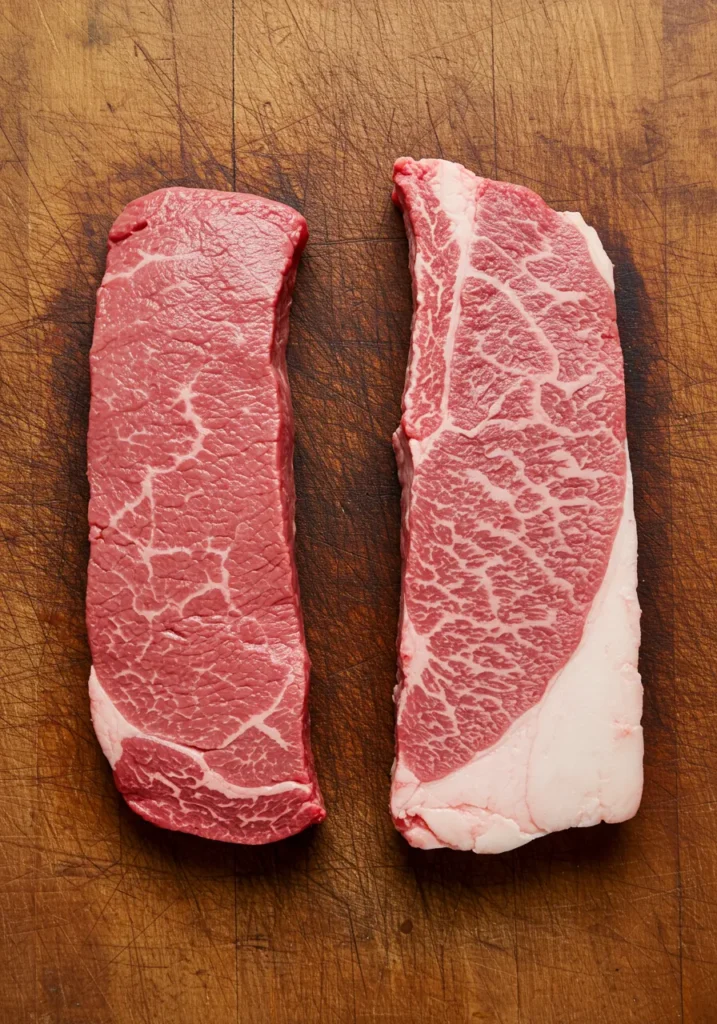
The number one question is always: “Isn’t tri-tip too lean to cook like a brisket?” It’s a fair question. While a tri tip vs brisket comparison shows tri-tip is significantly leaner, it contains just enough intramuscular fat and connective tissue (collagen) to perform magic under low-and-slow conditions. When cooked past its steak phase (135°F) and into the 200°F+ range, that collagen breaks down into rich, unctuous gelatin. This process is what transforms a potentially tough cut into a succulent, tender masterpiece.
Here’s a quick breakdown of how the “Trisket” stacks up against a traditional full packer brisket:
| Factor | Brisket-Style Tri-Tip (“Trisket”) | Traditional Packer Brisket |
| Cook Time | 4-6 hours | 10-14+ hours |
| Cost | Typically lower per piece | Higher initial cost due to size |
| Flavor | Deeply beefy, bark-forward | The gold standard of beef flavor |
| Forgiveness | Less forgiving due to leanness | More forgiving due to high fat content |
Essential Equipment & Ingredients
You don’t need a massive rig to create a perfect brisket style tri tip. Here’s the essential gear:
- The Cut: Look for a 2.5-3 lb tri-tip with good marbling. If you can find one with the fat cap left on, grab it! It adds a crucial layer of flavor and moisture during the cook.
- The Smoker: This method works beautifully on any smoker that can hold a steady temperature, including a pellet grill, offset smoker, or Kamado-style cooker.
- The Rub: Flavor is king. Here are two fantastic options:
- Texas Style SPG Rub: A simple, bold choice. Combine 2 parts coarse black pepper, 2 parts kosher salt, and 1 part garlic powder.
- Sweet & Savory Rub: For more complexity, mix 1/4 cup brown sugar, 2 tbsp paprika, 2 tbsp black pepper, 1 tbsp kosher salt, 1 tbsp chili powder, and 1 tsp onion powder.
- The Wrap: You have choices, and each affects the final bark.
- Butcher Paper: The best option for a crisp, breathable bark.
- Aluminum Foil: Creates a harder braise, resulting in maximum tenderness but a softer bark.
- Foil Boat: A hybrid method where you place the tri-tip in a “boat” of foil, leaving the top exposed to preserve the bark while accelerating the cook.
- The Thermometer: This is non-negotiable. A quality multi-probe digital meat thermometer is the only way to accurately track your smoked tri tip temp and know exactly when it’s done.
The Foolproof 5-Step Brisket-Style Tri-Tip Method
This is the core of how to smoke a tri tip to perfection. Follow these steps, and you won’t fail.
Step 1: The Prep (Trimming & Seasoning)
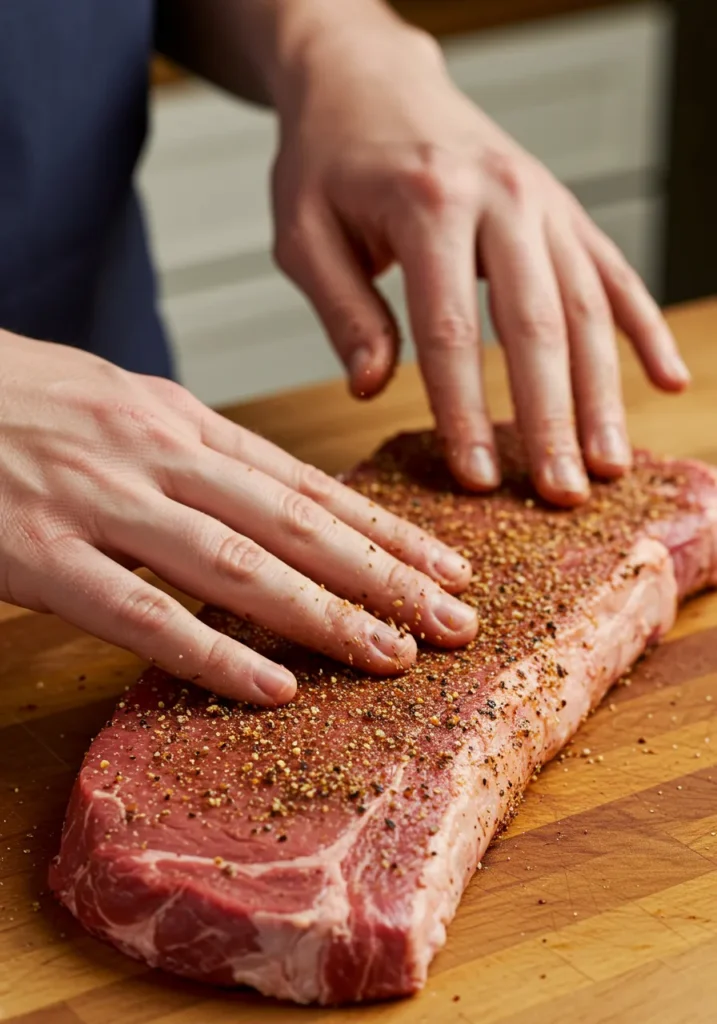
Pat the tri-tip completely dry. If it has a thick fat cap, trim it down to about a 1/4-inch thickness. Remove any hard, waxy “silverskin” from the meat side, as it will not render down. Apply a generous, even coat of your chosen rub to all sides.
Pro Tip: For the deepest flavor, apply the rub the night before, place the tri-tip on a wire rack over a baking sheet, and let it dry brine in the refrigerator overnight.
Step 2: The Smoke (Building the Bark)
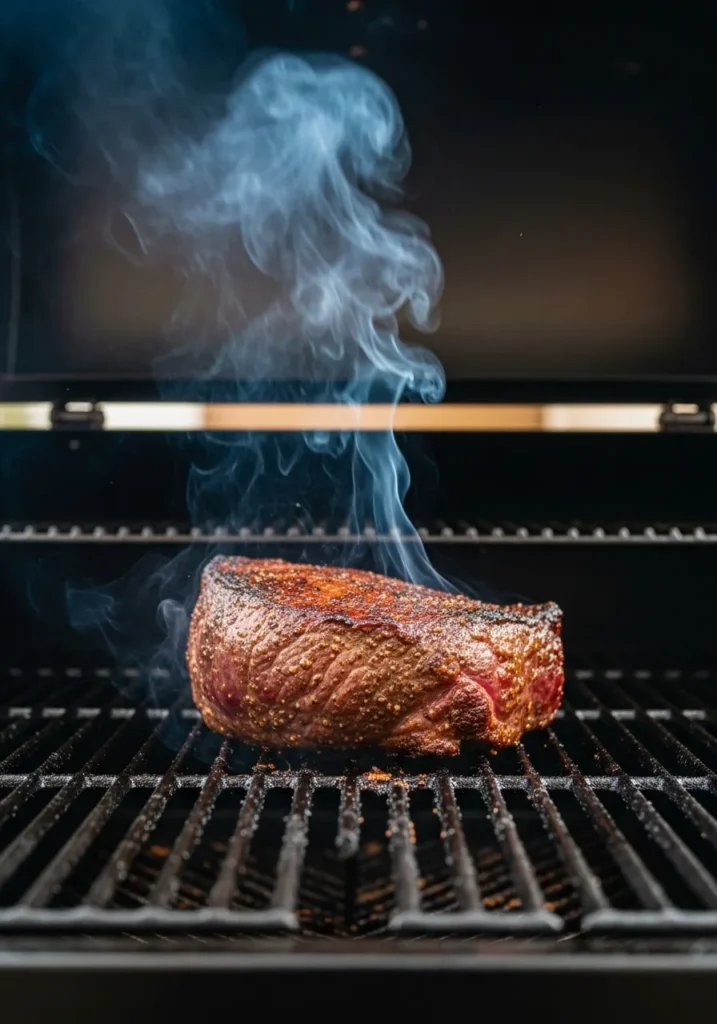
Preheat your smoker to 225°F – 250°F. For wood choice, go with classics like oak, hickory, or pecan. Place the tri-tip directly on the grates and smoke until a deep, mahogany-colored bark has formed and the internal temperature reaches around 165°F. This initial phase is where the magic of the Maillard reaction creates that irresistible crust.
Step 3: The Wrap (Pushing Through The Stall)
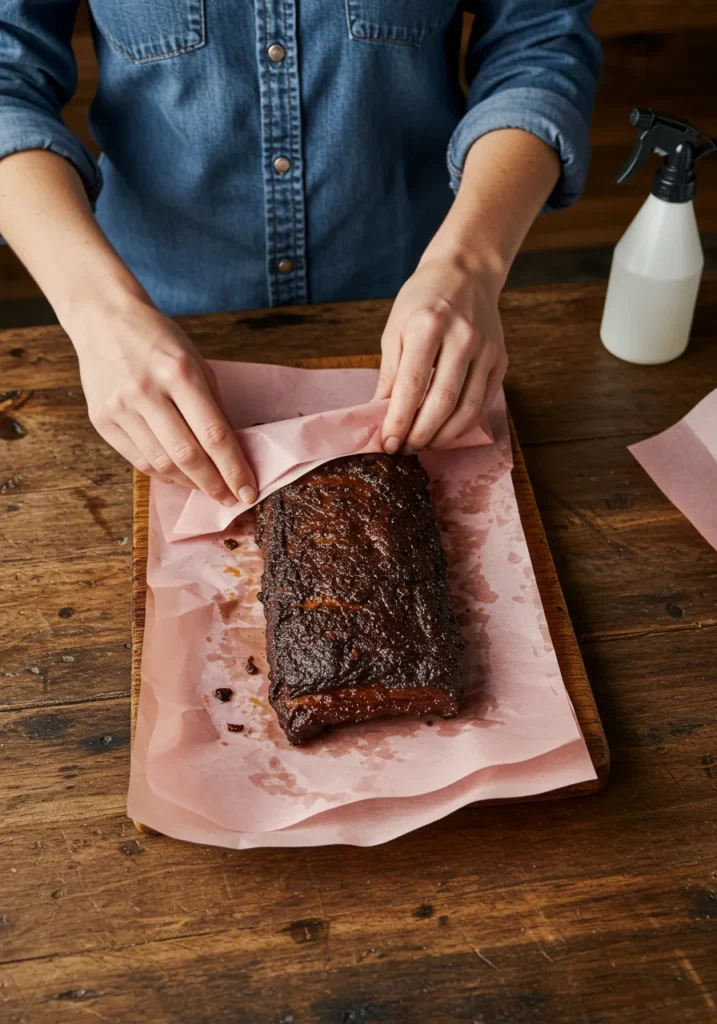
Around 165°F, you’ll encounter the infamous temperature “stall,” where the temp plateaus as moisture evaporates from the surface. To push through it, it’s time to wrap. Place the tri-tip on a large sheet of butcher paper or foil. You can add a few pats of butter or a spoonful of beef tallow on top before wrapping for extra richness. Wrap it as tightly as possible to create a seal.
Step 4: The Final Push (Getting to Tender)

Place the wrapped tri-tip back on the smoker. Now, we shift our focus from a specific number to a specific feel. Your target internal temperature is 203°F – 205°F, but the real goal is “probe tenderness.” Start checking around 200°F by inserting your thermometer probe into the thickest part of the meat. What temperature is tri tip done? It’s done when the probe slides in and out with almost no resistance, like probing a stick of room-temperature butter.
Step 5: The Rest (The Most Crucial Step)
Once probe tender, pull the tri-tip from the smoker and let it rest for a minimum of one hour. You can rest it on the counter (still wrapped) or for a longer hold, place it in a dry cooler (without ice). Do not skip this step! Resting allows the muscle fibers to relax and reabsorb all those precious juices, ensuring a moist final product.
How to Slice Tri-Tip Correctly
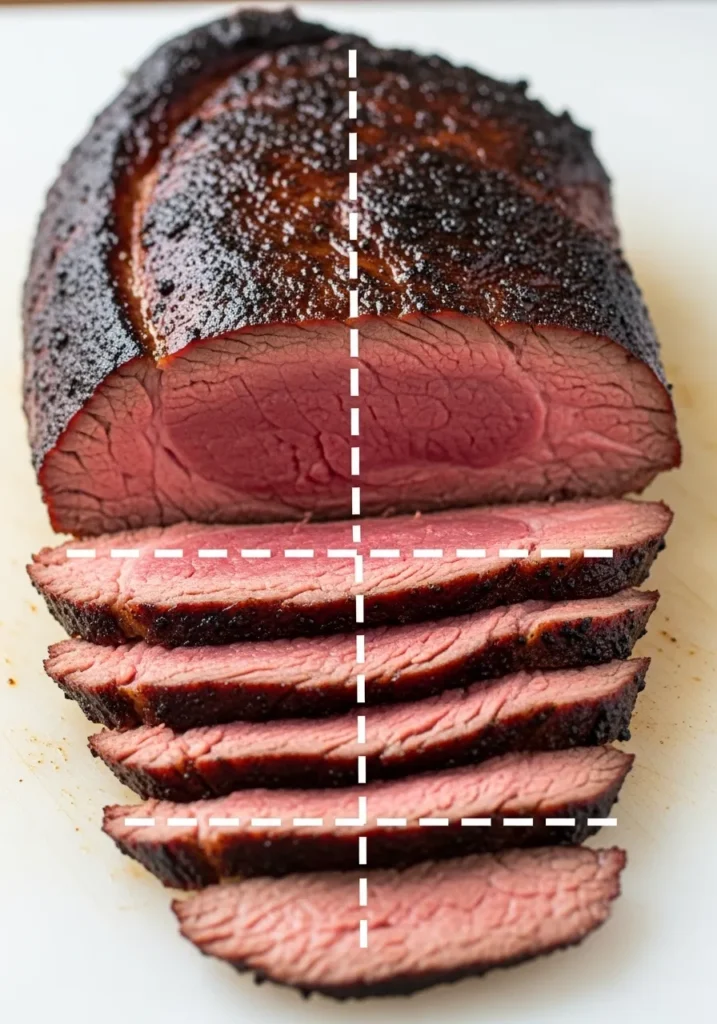
Slicing a tri-tip incorrectly can ruin a perfect cook. It’s composed of two different muscles whose grains run in different directions.
- Locate the Seam: Look at the raw or cooked tri-tip. You’ll see a line of fat that separates the longer, fan-shaped muscle from the smaller, triangular muscle section.
- Separate: Cut the tri-tip in half directly along that fat seam. You now have two separate pieces.
- Slice Against the Grain: Analyze the grain direction of each piece and slice them both against the grain into pencil-thick slices.
Troubleshooting & Pro-Tips
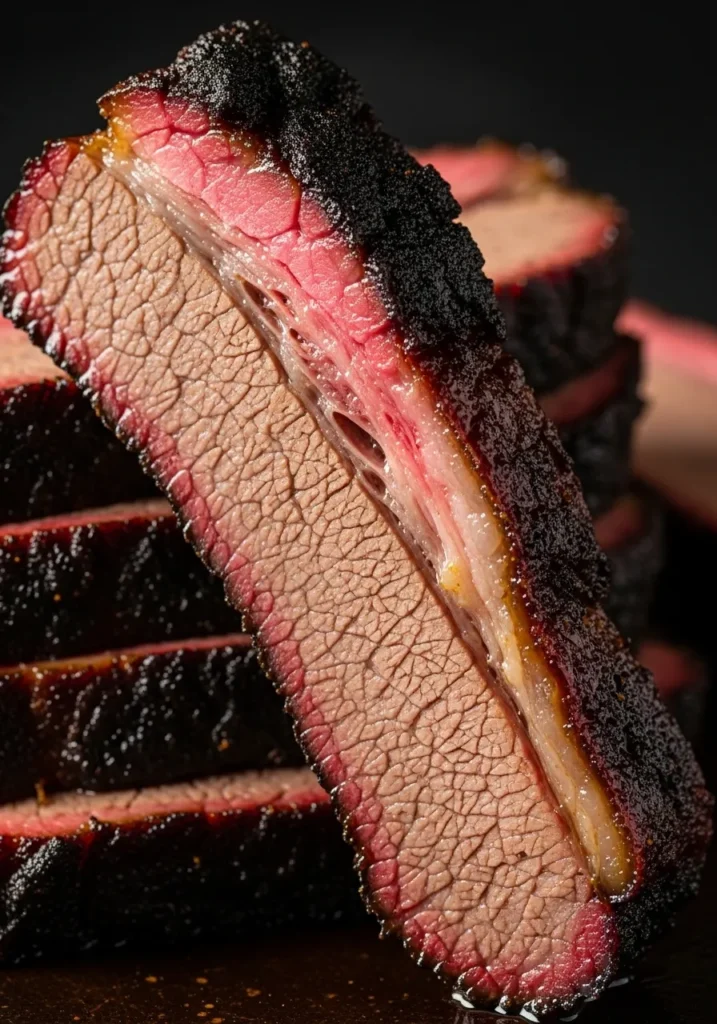
- “My tri-tip came out dry!” This is often caused by not wrapping it, pulling it at too high a temperature, or not resting it long enough.
- “My bark is soft!” You likely wrapped it in foil too early, before the bark was fully set. Try butcher paper or the foil boat method next time.
- “It’s not tender like brisket!” This is the most common issue. You pulled it based on temperature alone, not on the feel of “probe tender.” You have to wait for that collagen to fully break down.
FAQ: Brisket-Style Tri-Tip
What temperature is tri-tip done? For a classic medium-rare steak texture, pull the tri-tip at 130-135°F. For a tender, brisket-style result, cook it until it is “probe tender,” which is typically between 203-205°F.
How do you smoke a tri-tip? Season the tri-tip generously and smoke it at 225-250°F until a dark bark forms (~165°F internal). Then, wrap it in butcher paper or foil and continue cooking until it is probe tender before resting and slicing.
How long does it take to smoke a tri-tip like a brisket? Typically 4-6 hours, depending on the size of the roast and the exact temperature of your smoker.
Can you cook a tri-tip to 203°F without wrapping? You can, but it’s very difficult. The lean nature of the cut makes it prone to drying out during the long stall. Wrapping is highly recommended to retain moisture.
What’s the difference between “trisket” and steak-style tri-tip? Steak-style tri-tip is cooked hot and fast to a medium-rare temperature (130-135°F) and has a firm, steaky bite. Brisket-style is cooked low and slow to a high internal temperature (203°F) to become ultra-tender and shreddable.
Is tri-tip cheaper than brisket? Per pound, prices can be similar, but since a whole tri-tip is much smaller than a whole brisket, the total cost for a cook is significantly lower, making it a more accessible option.

Smoked Tri Tip Brisket Style (The “Trisket”)
Equipment
- 1 Smoker Pellet grill, offset, or Kamado
- 1 Digital Meat Thermometer Multi-probe recommended
- Butcher Paper or Foil
- 1 Sharp Carving Knife
Ingredients
- 1 Tri-Tip Roast 2.5 to 3 lbs
- 1 tbsp Beef Tallow or Butter optional, for wrapping
Ingredient Group: Texas Style SPG Rub
- 2 tbsp Coarse Black Pepper
- 2 tbsp Kosher Salt
- 1 tbsp Garlic Powder
Instructions
- Prep & Season: Trim the fat cap on the tri-tip to about 1/4-inch and remove any tough silverskin. In a small bowl, mix the coarse black pepper, kosher salt, and garlic powder. Apply the rub generously to all sides of the meat.
- Preheat Smoker: Preheat your smoker to 250°F. Use oak, hickory, or pecan wood for a classic BBQ flavor.
- Smoke: Place the tri-tip directly on the smoker grates. Cook for about 2.5-3 hours, or until a deep, dark mahogany bark has formed and the internal temperature reaches approximately 165°F.
- Wrap: Lay out a large sheet of butcher paper. Place the tri-tip in the center and top with beef tallow or butter (if using). Wrap the tri-tip as tightly as possible and return it to the smoker.
- Finish Cooking: Continue to cook the wrapped tri-tip for another 2-3 hours, or until the internal temperature reaches 203-205°F. The true test for doneness is when a thermometer probe slides into the thickest part of the meat with almost no resistance (like probing soft butter).
- Rest: Remove the tri-tip from the smoker. Let it rest, still wrapped, in a dry cooler or on your counter for at least 1 hour. This step is crucial for a juicy result.
- Slice & Serve: Unwrap the tri-tip. Identify the two different muscle groups and separate them. Slice each section against the grain into pencil-thick slices and serve immediately.
Video
Notes
- Probe Tender is Key: Don’t just rely on the final temperature. The tri-tip is done when your thermometer probe slides in and out of the thickest part with almost no resistance.
- Overnight Dry Brine: For the most flavor, apply the rub the night before and let the tri-tip rest uncovered on a wire rack in the refrigerator.
- Slicing is Crucial: Remember to slice against the grain for maximum tenderness. Tri-tip has two different grain directions, so be sure to separate the muscles before slicing.
Did You Try Our Recipe?
There are no reviews yet. Be the first one to write one.

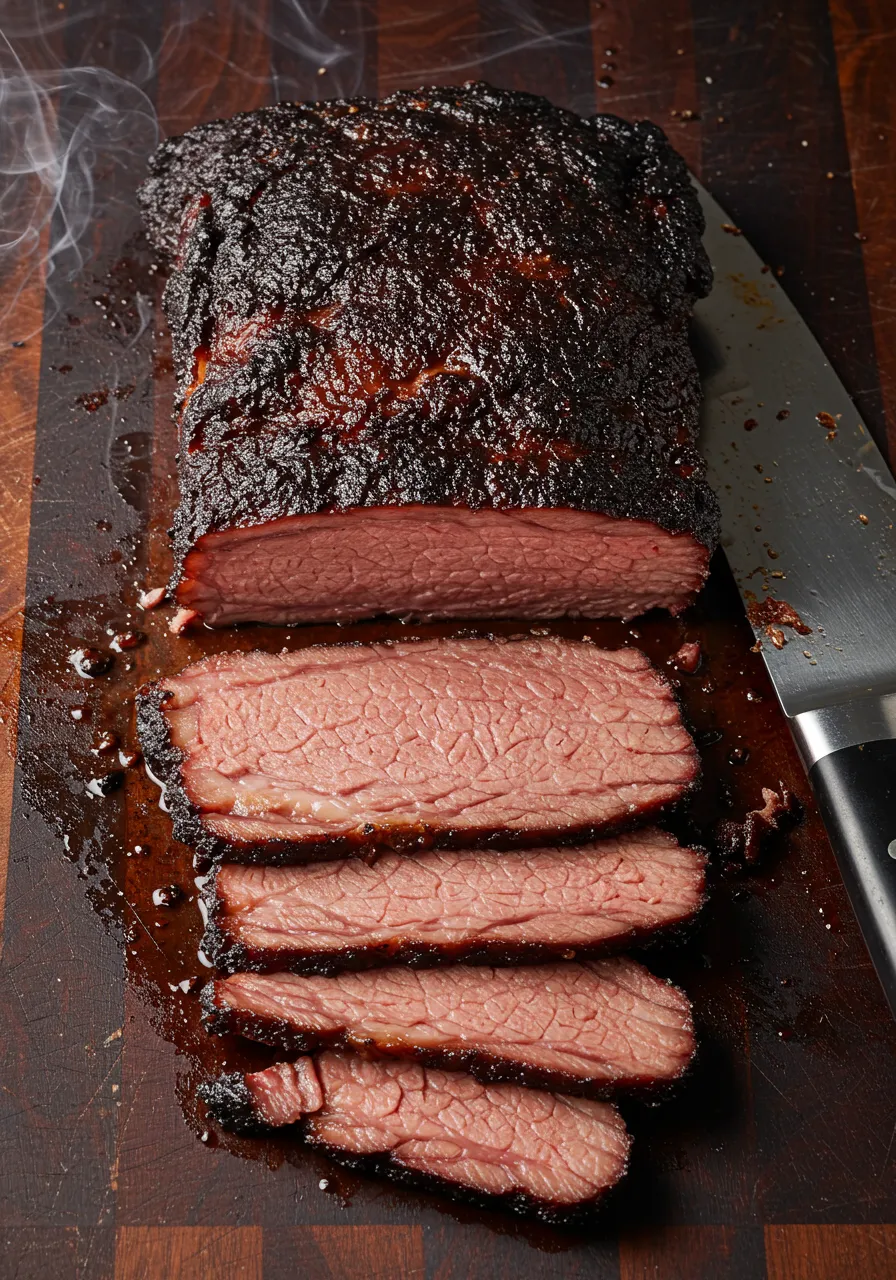
Comments are closed.